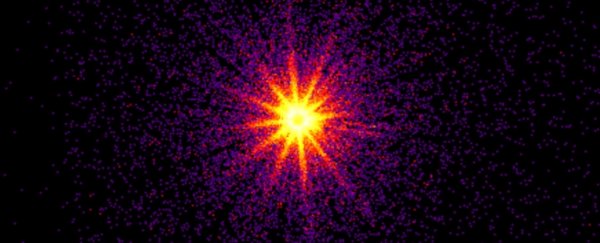A black hole flickering in the Milky Way galaxy has been filmed in unprecedented detail, with a new high frame-rate technique that is helping us understand the wild dynamics of these most enigmatic objects.
The black hole is named MAXI J1820+070, discovered in 2018, roughly 7 times the mass of the Sun and just 10,000 light-years from Earth.
As far as black holes go, it's way small - the lowest mass that we think a black hole can be is around 5 Suns - but there's something else really interesting about it. It's flickering, emitting a whole bunch of X-ray and visible light radiation, as it actively slurps down matter from a nearby star.
Normally black holes - especially small, quiescent black holes - are very hard to see. Sagittarius A*, the supermassive black hole at the centre of the Milky Way, is relatively quiet, but it's also easy, because we can track the orbits of things moving around it.
But Sgr A* is 4 million times the mass of the Sun, and therefore acts as the centre of a massive system. A black hole only 7 times the mass of the Sun isn't likely to have as many orbiters. However, many stars (including dead stars like black holes) are in binary systems with other stars - and such black holes can eat up material stripped off their binary companions.
That's what astronomers believe is happening with MAXI J1820+070. As the black hole strips its BFF star, the material forms an accretion disc around the black hole, where frictional, magnetic and gravitational forces compress it and create incredible heat.
In turn, this produces flickering electromagnetic radiation, and this is what the researchers captured, at a rate of over 300 frames per second, in optical light using the HiPERCAM instrument on the Gran Telescopio Canarias and in X-rays by NASA's NICER observatory on the International Space Station.
"The movie was made using real data, but slowed down to 1/10th of actual speed to allow the most rapid flares to be discerned by the human eye," said astronomer John Paice of the University of Southampton and the Inter-University Centre for Astronomy & Astrophysics .
"We can see how the material around the black hole is so bright, it's outshining the star that it is consuming, and the fastest flickers last only a few milliseconds - that's the output of a hundred Suns and more being emitted in the blink of an eye!"
This multi-messenger approach meant that the team could simultaneously track both types of radiation, a rise in one was accompanied by a rise in the other.
But, interestingly, there was a time gap: optical light flashes were preceded just a split-second before by X-ray flashes - a signal that, the researchers said, indicated the presence of plasma, a highly ionised and electrically conductive state of matter, extremely close to the black hole.
Two other times has this time delay between X-ray flash and optical flash been detected in actively accreting black holes, once in 2017 and again in 2018.
This third time is indeed the charm, being the most detailed observation of the phenomenon yet. And, to mangle an Ian Fleming quote, once is chance; twice is a coincidence; but the third time is indicative of a pattern.
"The fact that we now see this in three systems strengthens the idea that it is a unifying characteristic of such growing black holes. If true, this must be telling us something fundamental about how plasma flows around black holes operate," said astronomer Poshak Gandhi of the University of Southampton.
"Our best ideas invoke a deep connection between inspiralling and outflowing bits of the plasma. But these are extreme physical conditions that we cannot replicate in Earth laboratories, and we don't understand how nature manages this. Such data will be crucial for homing in on the correct theory."
The research has been published in Monthly Notices of the Royal Astronomical Society.
